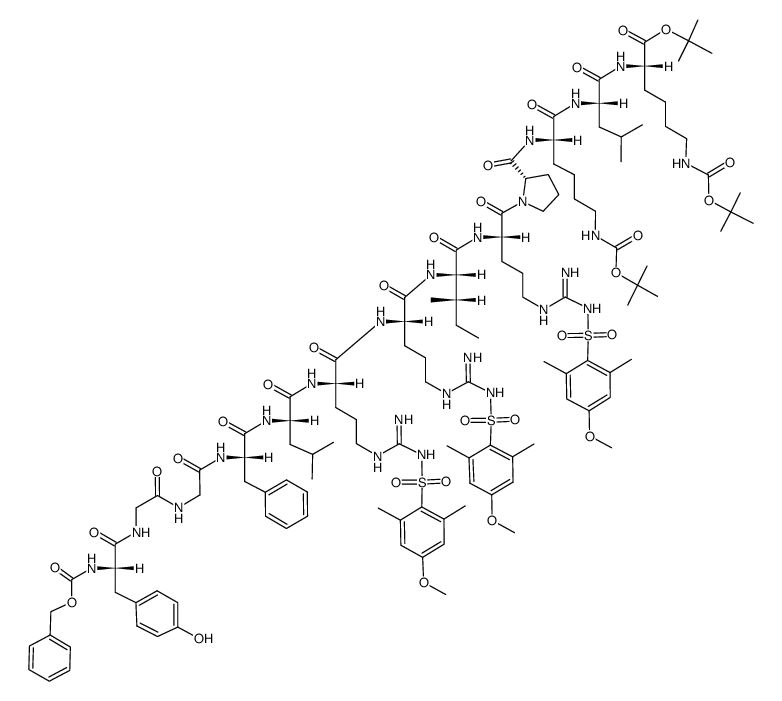Dynorphin A (1-13)

Dynorphin A (1-13) structure
|
Common Name | Dynorphin A (1-13) | ||
|---|---|---|---|---|
| CAS Number | 72957-38-1 | Molecular Weight | 1603.955 | |
| Density | 1.4±0.1 g/cm3 | Boiling Point | N/A | |
| Molecular Formula | C75H126N24O15 | Melting Point | N/A | |
| MSDS | Chinese USA | Flash Point | N/A | |
Use of Dynorphin A (1-13)Porcine dynorphin A (1-13) is a potent, endogenous κ opioid receptor agonist and is antinociceptive at physiological concentrations. Sequence: Tyr-Gly-Gly-Phe-Leu-Arg-Arg-Ile-Arg-Pro-Lys-Leu-Lys. |
| Name | Dynorphin A (1-13) |
|---|---|
| Synonym | More Synonyms |
| Description | Porcine dynorphin A (1-13) is a potent, endogenous κ opioid receptor agonist and is antinociceptive at physiological concentrations. Sequence: Tyr-Gly-Gly-Phe-Leu-Arg-Arg-Ile-Arg-Pro-Lys-Leu-Lys. |
|---|---|
| Related Catalog | |
| Target |
Κ opioid receptor[1]. |
| In Vivo | Dynorphin A (1-13) exposure (33 μM) causes a significant loss in neuronal viability at 4 h with a visible destruction in neuronal morphology seen at 16 h. Exposure to dynorphin A (1-13) causes acute increases in [Ca2+]i in individual neurons similar to increases seen with acute NMDA treatment. Continuous exposure to dynorphin A (1-13) (100 μM) causes a significant loss of neurons over time[1]. |
| References |
| Density | 1.4±0.1 g/cm3 |
|---|---|
| Molecular Formula | C75H126N24O15 |
| Molecular Weight | 1603.955 |
| Exact Mass | 1602.983398 |
| PSA | 661.70000 |
| LogP | -0.50 |
| Index of Refraction | 1.645 |
| InChIKey | OVVIBUHLQIYUEU-IWIISZHXSA-N |
| SMILES | CCC(C)C(NC(=O)C(CCCN=C(N)N)NC(=O)C(CCCN=C(N)N)NC(=O)C(CC(C)C)NC(=O)C(Cc1ccccc1)NC(=O)CNC(=O)CNC(=O)C(N)Cc1ccc(O)cc1)C(=O)NC(CCCN=C(N)N)C(=O)N1CCCC1C(=O)NC(CCCCN)C(=O)NC(CC(C)C)C(=O)NC(CCCCN)C(=O)O |
| Storage condition | -20°C |
| Personal Protective Equipment | Eyeshields;Gloves;type N95 (US);type P1 (EN143) respirator filter |
|---|---|
| RIDADR | NONH for all modes of transport |
| WGK Germany | 3 |
|
~57% 
Dynorphin A (1-13) CAS#:72957-38-1 |
| Literature: Wakimasu; Kitada; Fujino Chemical and Pharmaceutical Bulletin, 1981 , vol. 29, # 9 p. 2592 - 2597 |
| Precursor 1 | |
|---|---|
| DownStream 0 | |
|
Isosteric replacement of acidic with neutral residues in extracellular loop-2 of the kappa-opioid receptor does not affect dynorphin A(1-13) affinity and function.
J. Med. Chem. 43(7) , 1251-2, (2000)
|
|
|
Central reinforcing effects of ethanol are blocked by catalase inhibition.
Alcohol 41(7) , 525-34, (2007) Recent studies have systematically indicated that newborn rats are highly sensitive to ethanol's positive reinforcing effects. Central administrations of ethanol (25-200mg %) associated with an olfact... |
|
|
Through central arginine vasopressin, not oxytocin and endogenous opiate peptides, glutamate sodium induces hypothalamic paraventricular nucleus enhancing acupuncture analgesia in the rat.
Neurosci. Res. 54(1) , 49-56, (2006) Our previous study proved that the hypothalamic paraventricular nucleus (PVH) plays an important role in acupuncture analgesia. The neuropeptides involving in the PVH regulation of acupuncture analges... |
| UNII:VFC23V742Z |
| dynorphin A-(1-13) |
| DYNORPHIN 1-13 |
| DYNORPHIN A (1-13),PORCINE |
| dyn A-(1-13)-OH |
| L-Tyrosylglycylglycyl-L-phenylalanyl-L-leucyl-L-arginyl-L-arginyl-L-isoleucyl-L-arginyl-L-prolyl-L-lysyl-L-leucyl-L-lysine |
| DYNORPHIN A(HUMAN,1-13) |
| YGGFLRRIRPKLK |
| L-Lysine, L-tyrosylglycylglycyl-L-phenylalanyl-L-leucyl-L-arginyl-L-arginyl-L-isoleucyl-L-arginyl-L-prolyl-L-lysyl-L-leucyl- |
| Tyr-Gly-Gly-Phe-Leu-Arg-Arg-Ile-Arg-Pro-Lys-Leu-Lys |
| Dyn(1-13) |
| DYNORPHIN A PORCINE FRAGMENT 1-13 |
| Dynorphin A (1-13) Acetate |
| Porcine dynorphin A(1-13) |
